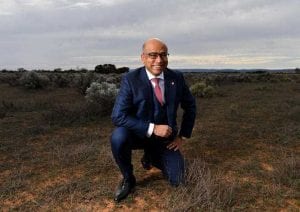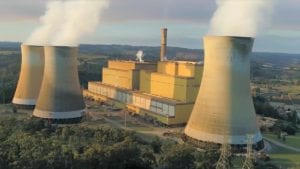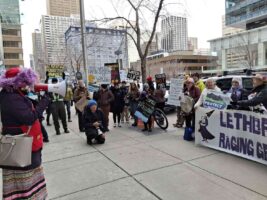This is a slightly edited transcript of an interview between RenewEconomy editor Giles Parkinson and Alinta CEO Jeff Dimery on the merits of a capacity market, and including coal at least for the short term.
It was the subject of this article – Alinta seeks biomass options for Loy Yang B, says capacity market for coal could end in 2029 – but here is the interview in full:
Giles Parkinson: It’s not entirely clear what a capacity market might have done differently to the situation we’re seeing now in Queensland; how it would have managed the soaring price of coal and gas?
Jeff Dimery: So about about 18 months ago, it was being well communicated that we were experiencing the lowest wholesale prices that we’ve seen in virtually 20 years, or so. And there’s a lot of people including myself on the record, when we had the really high price cycle last time, as saying that high prices fix high prices and the same is true for low prices fix low prices, because people don’t invest …and that kicks off your next cycle.
The problem with gross markets is that you go to the extremes of commodities, whereas the capacity market creates a lot more stability and certainty and you can invest through the cycles.
So you take a capacity market, back 18 months ago, when pool prices were low, but there was a lot of pressure, especially on the public energy companies, around getting out of coal.
So you think about it, you think I’ve got this thing that’s pretty much uneconomic at the moment, and I’m being hounded to get out – you’re not about to throw a whole lot of money at it for operations and maintenance preserving the life of the asset. And that gets even worse when you’ve announced, you know, that you’re going to close the asset.
When those decisions are made at that point in time, it’s not a problem. It takes years for these things to wash through the system. And so it was that environment that’s created the investment environment, the commercial environment, that I think has created the issues of today.
And if you’d had a capacity payment mechanism in place back then that would have incentivised those generators to keep investing, and I don’t think we’d be in a situation we find ourselves in today.
GP: Looking at Queensland, though – what are they not spending now? They’re mostly state-owned generators – obviously well funded. What are they not spending on maintenance that they would have been spending, say, if they had a capacity market?
JD: Take a gas-fired peaker, for instance. So under a capacity market, you earn an income because you’ve been paid to be ready and available. And being ready and available means making sure you have sufficient fuel supply to be ready and available. Whereas under the gross pool system, you can look at the market and say look, when I’m called upon to generate I know pool prices will be high and therefore I’ll procure the gas as I go and generate into that… But if you don’t buy the gas, then the gas market gets tight. And then the gas isn’t available.
So again, part of what the capacity market will do is shore up fuel supplies. And the same can be said for those coal fired generators who haven’t had their coal. If they’d had the certainly of a payment out to this period, they would have had fuel supply organised – or I assume they would, that would be prudent. And some of the situation could have been avoided. So you know, I’m not saying it’s the perfect solution to all of the problems, but it would have taken away a lot of the ones that we do have.
GP: One of the biggest criticisms I’ve heard about the capacity markets is from people who say, well, it just gives coal generators more money, without guaranteeing that they will spend it on maintenance.
JD: Well, they don’t understand the market. Because, the way that the market works is what what’s given in one hand can be taken away with the other. So if I get a capacity payment, and the time comes and I don’t front, and I’m needed, I get heavily punished. And so I pay back all the capacity payment and potentially – depending on how you want to structure this – you can pay it back with interest.
So you can penalise, you know, for not being there. It’s not… a gift and a free kick where once a year, say, this is how much I’m gonna have if someone hands you a check, and you’re right off into the sunset. It’s not how capacity markets work. And that money gets redistributed back to customers right away, not to other participants.
So, I would say anybody with that criticism doesn’t understand capacity markets and the way that they work. It’s as much a risk – and it’s an interesting question for for people who haven’t maintained their assets. How do you feel about a capacity market? I’d say I feel pretty anxious. Who wants to be given a notional capacity payment based on you know, average performance, expected performance across the market and then perform below average? By definition, it’s going to hurt so it raises the bar, which is one of the reasons we think it’s a great idea.
GP: So how do you construct a capacity market that is fair and balanced and doesn’t result in over-payments, or where you’ve got things being built which are never switched on – how do you structure that?
JD: I think this is a much better discussion. Let me just say, if we’re talking about how to structure a capacity market more efficiently, I think that’s the right discussion. But here’s my two cents’ worth, anyway…
Firstly, it’s about security and acknowledging we’re on a path for emissions reduction – so having a lever that allows government to adjust for emissions. We think that’s wise and sensible. And depending on where you’re at, in the transition to renewable, you can go harder or not as hard on that depending on your insurance policy for security through thermal generation.
So give yourself the levers – and that’s why we said, include coal until 2029, if you’ve got 2030 targets, then exclude it. And if you get to 2030 and and by excluding it the lights are going out then include it again and acknowledge, you know, that you’re going to have to adjust your timeframe slightly. But it’s better than betting the farm and, and losing everything.
The second point is anybody who says coal or gas should be excluded, my challenge to them is, 2025 is two-and-a-half years away, right? Who’s gonna build what in two-and-a-half years? I mean, these are big complex projects … Offshore wind farms take four or five years to develop, even with the best O&M team in the world.
So you tell me how we’re going to supply gas or electricity to Victorians without gas and coal generation being part of any capacity mechanism and I’ll take my hat off to you and say, congratulations, you’re a genius, because no one else can see.
But that’s just common sense. Right? And I hate being labeled a “coal guy” with all of this, because …we’re doing heaps in this space and we’ve got another big announcement in a few weeks on the renewable front… But equally, I’ve got 1.1 million customers I want to keep energy affordable for and keep the lights on to.
GP: So you’re talking about giving coal capacity payments to 2029, if your 2030 emissions target depends on it, and then review it and if you if you’re worried that the lights will go out, then extend it … What are you saying to the market about the life of your asset, Loy Yang B which I think … is probably going to be the last to close? What you’re telling them is, look, we’ll be out of there by 2030 if you can build enough stuff, and you got a target you want to meet, then we can disappear.
JD: Right, exactly. So we’re not waiting around – we too want to transition away from coal, right? The difference between us and some of our competitors is we’re not telling our employees we’re shutting down or bringing forward closure. We’re saying to them, we’re going to investigate all plausible opportunities to keep you going, albeit it might be on call.
I’ve been doing this for 30 years, as I sit here and look at it, there’s not enough wind, solar and battery to get us through. We have to have an alternative. You know, and some might say nuclear and I say, well, good luck to you people – that’s pie in the sky. But there are other alternative fuels like biomass that have been successfully integrated overseas. And so how do we set up the proper supply chain for that, in Australia? What will it cost? What does it look like? So that we can have sensible discussions.
Back to the capacity mechanism, my view is this: So, Loy Yang B is available to transition. It does participate in a capacity market at the front end, albeit for the next four years, where we get our plans in place to to transfer away from coal.
When you set up a capacity market, not all capacity credits are equal. You could auction off a capacity strip for 15 years that we’d be really interested to bid for the Oven Mountain pumped hydro scheme to underwrite that project – which is what the market needs, and that’s good. But Loy Yang B couldn’t participate in that because it’s not guaranteed to be in the scheme beyond 2029.
So you are doing what Chris Bowen wants to do, which is facilitate new technology, low emission development. But at the same time, by auctioning off capacity credits for one, two, three and and four years, you’re securing your your supply in the short term.
And then, as I say, as more and more of those [new] projects become evident, and come online, then you you start to eliminate those shorter term certificates on those projects that are old technology or higher emissions and you get, you know, as best as we can a smooth transition. That’s what we’re espousing. Nothing more, nothing less. We just think it’s obvious common sense.
GP: What sort of money do you think needs to be paid to the coal generators and the gas generators to make it worthwhile?
JD: If you look at the WA market, what you would do is you would introduce a capacity payment, but you would then limit the pool price. So the current pool price cap, it’s at $15,500, you know. Under a scheme that we’re proposing, you’d probably cut that pool price cap back to a number like $5,000 – so you take $10,000 off the top of the market. Because what you’re doing is you’re getting rid of volatility.
Now, you will come back to me and say, ‘Well, Jeff, when you look at the WA market, it could be more efficient.’ Part of that efficiency is about having the courage to predict accurately how much capacity is required, and not taking a safe option of over predicting what the capacity will be – because that’s where you pay out more than you should. But in an efficiently estimated demand-side of the market, where the capacity is tailored, it can be very efficient, and you can get rid of that volatility.
None of us – politicians, energy participants – none of us like reading that the pool price sat at $15,500 in Queensland last night, because it just leads to heartache – I can tell you.
So, getting those measures right and having one offset the other, to me is what it’s all about. …This is not a cry for more money from the industry. Let’s be very clear about that. It’s not at all. It just means that, you know, you’re gonna make less money in pool receipts, but more money in contracted revenue, which gives you greater certainty to go and hedge your fuel supply. That’s what I’m talking about.
GP: What’s the impact of Snowy 2.0 delay? And what do you understand the delay is? If it is 2028, what does that mean? Because it has been such a bloody big project and there’s been questions about whether it was the most efficient way of going about things … and at the same time, it’s caused other projects not to go ahead.
JD: So I take from Minister Bowen’s comments the other day that they’re forecasting around 2028 delivery now. So yeah, it would appear to be a delay on what the market was led to believe. …Am I surprised by that? No, I’m not.
I was on record as saying that they had no chance to deliver against the original timeframes that were put up when Malcolm Turnbull was pushing for this thing – we didn’t believe the budget and we didn’t believe the timeframe. I think what is has now been articulated is real – so it’s more in line with what I would have thought was possible at a cost that that is achievable. Was it the right solution and a point in time? I’m not sure it was, but the decision was made and the rest of the market is formed around it.
Again, it highlights why you meet – at the front end of the capacity market – insurance leaders. Because when things don’t pan out the way that you intend them to, or plan them to, you’ve got to protect consumers. It’s not just about politics and and optics, it’s about real life energy supply.
So for those reasons, we keep coming back to what we’re proposing as a sensible solution that allows us to hit our aspirations as a nation for emission reduction, keep the lights on and help make energy more affordable to consumers.
We’re not sitting here getting fat and happy on coal
GP: Can this be a mechanism that actually deliver on the Paris target – which is to limit warming to 1.5 degrees or as close as you can. Can a capacity market be consistent with that? I mean, can it make payments and still get you guys … out of the system quickly enough to save the rest of the planet?
JD: We’re getting out of the system – just have a look at Origin, look at look at AGL. We’re no different. We’ve all got plans to get out. No one is sitting here saying ‘I’m gonna get fat and happy on coal.’ It’s just not happening. Anyone who thinks that just isn’t close enough to what’s going on?
You’re in fact trying to solve … the opposite dilemma, which is, ‘Don’t scramble out too quickly, you blokes – not until we don’t need you.’ So, I think if people start to think about the challenge in that way, then we’ll have a proper conversation. But when people hear this nonsense of coal keeper and whatever, it’s absolute rubbish.
We’re all marching towards net zero. Now, I’m happy to have a discussion about, you know, could you tweak this or that and be a little bit more aggressive. I’ve got in the Alinta portfolio around about $7 billion of renewable projects that have government seed funding for the development phase, but I can assure you I don’t have $7 billion waiting to invest in coal. I haven’t got anything, basically, which is part of the problem.
GP: I’m quite fascinated by what you’re proposing – 2029 as a short-term contract thing and you’re obviously sort of talking about it as an emissions target, and then you’re sort of saying, well, the caveat is do you have enough to pay to replace it? So you’re proposing this as a mechanism that ensures that the lights stay on until such time as we are absolutely clear that AMEO’s Step Change plan will actually be delivered. So in that scenario, then then you’d probably say, well, if Loy Yang B’s out of the market by 2032, as the current Step Change suggests, then so be it. If you find something useful to do with it, such as biomass or whatever it else, then good for you.
JD: That’s my challenge, I agree. But [we’ve also got to] think about, where’s the just transition? Where’s the planning communities? 2032 is not that far away – so what other policies are in place to support that transition? Not just from an energy perspective, but a broader community perspective?
GP: Well, that’s what the government’s got to come up with themselves, isn’t it? … I’m pretty sure they say in there somewhere that we do need actually address transition – we’ve got to figure out what the workers need and that we’ve got to plan for that…?
JD: That’s why we’re saying… take out an insurance policy. Don’t limit your options. When the picture becomes clearer, do what you need to do and – like I said, we’d probably be one of the major benefactors of this, quite frankly, because of how we’re looking to invest.
We’re not anti-renewables, quite the opposite. I just really want to stress that point. And again, judge us by what we do, not what we say… And we’ll be making, as I said, another announcement in the next few weeks, of a big scale, of further evidence of Alinta investing very heavily in renewables in the future.










